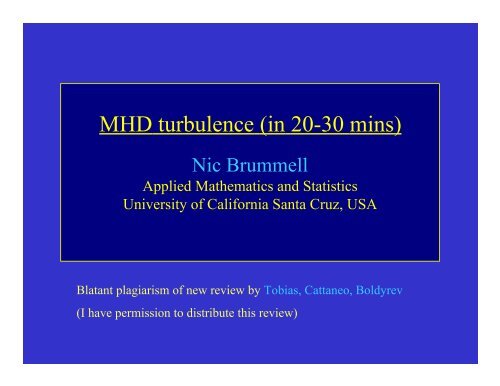PDF presentation - University of California, Santa Cruz
PDF presentation - University of California, Santa Cruz
PDF presentation - University of California, Santa Cruz
You also want an ePaper? Increase the reach of your titles
YUMPU automatically turns print PDFs into web optimized ePapers that Google loves.
MHD turbulence (in 20-30 mins)Nic BrummellApplied Mathematics and Statistics<strong>University</strong> <strong>of</strong> <strong>California</strong> <strong>Santa</strong> <strong>Cruz</strong>, USABlatant plagiarism <strong>of</strong> new review by Tobias, Cattaneo, Boldyrev(I have permission to distribute this review)
IntroductionMagnetic fields are ubiquitous in cosmological objectsHeard about hydrodynamic turbulence. What is the effect <strong>of</strong> magneticfield?Interaction <strong>of</strong> magnetic fields with electrically-conducting fluid gives riseto a complex system whose dynamics are distinctly different from– non-conducting fluid– magnetic field in a vacuumFrom system scale to dissipation scale is a wide range => turbulentElectrically-conducting fluid = plasma, but in many cases, MHD will do=> MHD TURBULENCEApplications: galaxy clusters, interstellar medium, stellar interiors,laboratory experiments, … etcIt is a BIG PROBLEM: isotropic homogeneous hydro turbulence spectrumsettled in the late 1940s; still arguing about MHD spectrum!
ComparisonSimilarities with hydro: Fundamental idea <strong>of</strong> energy transfer in turbulent cascade: injection ->inertial -> dissipationObjective: characterise the inertial regimeDifferences (more details later): More vector fields to deal with! (u and B)Dynamos! Self-magnetisation. No hydro equivalent. Can divide MHD turbulence into:– Large-scale field does not exist = dynamo case– Large-scale field already exists (imposed, or are just examining smallregion), is strong, and we are not concerned with it’s origin = guidefieldcase– (we will concentrate here on the latter )
DifferencesIn hydro, generally become progressively weaker at smaller scales untileventually unconstrained. e.g. rotation, stratificationIn MHD, there is no scale below which the fluid becomes unmagnetised!Very important: regular turbulence becomes more isotropic at small scales;MHD turbulence becomes progressively more anisotropic.– Hydro turbulence: small eddies advected by larger eddies withoutaffecting their dynamics (Galilean invariance; can remove mean flow)– => hydro turbulence becomes isotropic at small scale.– Hydro turbulence “forgets” influence <strong>of</strong> larger scales– Large-scale mean field cannot be removed by Galilean transformation.– Large-scale field mediates energy cascade at ALL scales in the inertialregime => weak small-scale turbulent fluctuations becomeprogressively more ANISOTROPIC (easier to shuffle field lines that tobend)– MHD “never forgets”!
The usual …Equations
Conserved quantitiesEnergyCross-helicityMagnetic helicityNotice: lim B->0, conservedquantities switch to energyand kinetic helicity =>fundamental differencesbetween hydro and MHD(Biskamp 2003) In presence <strong>of</strong> dissipation:Energy decays faster than magnetic and cross helicityEnergy cascades to small scales (like 3D hydro) (fluctuations in equipartition)Magnetic helicity cascades towards large-scales (like 2D hydro)Cross-helicity also cascades towards small-scales (but is not sign-definite, socan be amplified or destroyed locally; will lead to self-organisation [later])
Waves (incompressible)Small perturbation analysis with mean field reveals solutions as waves thatpropogate on the stationary and uniformly-magetised background.Shear Alfven waves:Dispersion -Polarisation -Two waves:Pseudo Alfven waves:Dispersion -Polarisation -Two waves:(Compressible: “Alfven”)(Compressible: “Slow”)
WavesHydro turbulence = eddies: MHD turbulence = eddies and wavesElsasser variables:For ideal, incompressible, unforced MHD equations, there exists EXACTNONLINEAR SOLN that is a NON-DISPERSIVE ALFVEN WAVEPACKETNonlinear interactions are collisions <strong>of</strong> counter-propogating wave packets andpackets get split and distorted until dissipated.WEAK MHD TURBULENCELinear (advection along guide field) >>nonlinear(distortion/transfer <strong>of</strong> energy)– Mean-fluctuating interactions dominate– Takes many interactions to distort the wave packets.– Weak MHD turbulence is an ensemble <strong>of</strong> weakly interacting waves.
Inertial scalingsISOTROPIC wave packets interactions (Iroshnikov 1963, Kraichnan 1965)Energy transfer requires MANY interactionsLeads toANISOTROPIC wave packets interactionsWeak turbulence: (Galtier et al. 2000)Resonant interactions dictatePseudo-Alfven waves decoupleEnergy cascades in direction <strong>of</strong> large
Inertial scalings (cont)ANISOTROPIC wave packets interactionsStrong turbulence: (Goldreich& Sridhar 1995; Cho & Vishniac 2000; Boldyrev 2005)Achieved when CRITICAL BALANCE– Fluctuating-fluctuating interactions comparable to mean-fluctuating– Field lines strongly bent now– Wave packets are distorted in one one interaction not many– Small wave packets are not guided by the original guide field but thelocally distorted field (disorted by larger packets)– Scale-dependent anisotropySpectrum:
Inertial scalings (cont)ANISOTROPIC wave packets interactionsStrong turbulence: (cont)BUT numerics findLatest theories explain this: (Boldyrev 2005, 2006)Flatter!Explains longer energy transfer times at small scales by DYNAMICALALIGNMENT.v and b aligned with scale dependent angle; reduces nonlinear interactions(Balanced … unbalanced …)
ConclusionsMHD guide-field turbulence very different from hydroCan be WEAK or STRONG:– Weak: mean-fluctuating interactions dominate– Strong: fluctuating-fluctuating are comparable– Transition in the inertial cascade? If strength <strong>of</strong> fluctuating-fluctuatinginteractions increase with smaller scales, should be a transition fromweak to strong turbulence in a sufficiently extended inertial regime(very difficult to simulate).Energy cascade ANISOTROPIC: transfer mostly transverse to the local meanfield.Polarisation vectors tend to align in the transverse plane: consequences forenergy spectrum.Elongation and alignment increase with decreasing scale


